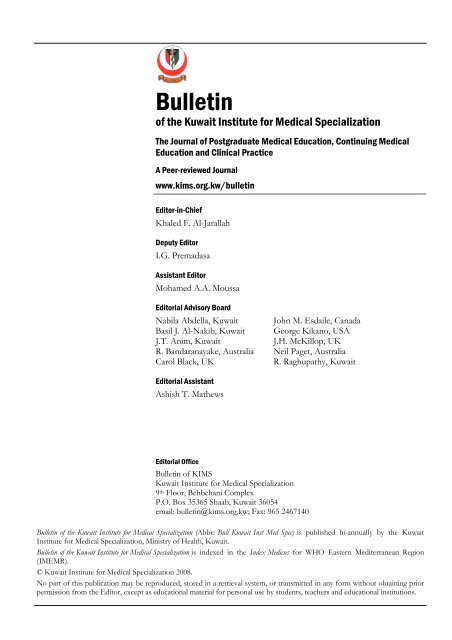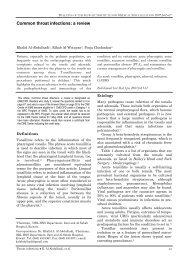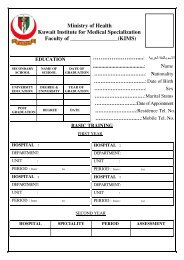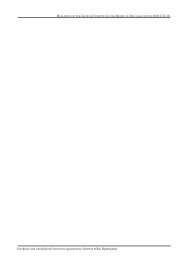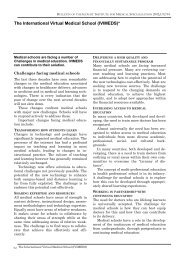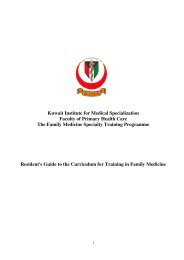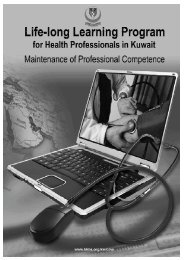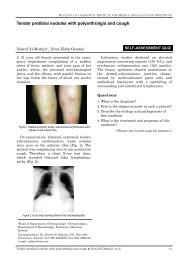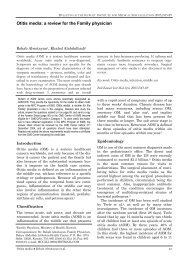Starting Pages.pdf - Kuwait Institute for Medical Specialization
Starting Pages.pdf - Kuwait Institute for Medical Specialization
Starting Pages.pdf - Kuwait Institute for Medical Specialization
You also want an ePaper? Increase the reach of your titles
YUMPU automatically turns print PDFs into web optimized ePapers that Google loves.
Bulletin<br />
of the <strong>Kuwait</strong> <strong>Institute</strong> <strong>for</strong> <strong>Medical</strong> <strong>Specialization</strong><br />
The Journal of Postgraduate <strong>Medical</strong> Education, Continuing <strong>Medical</strong><br />
Education and Clinical Practice<br />
A Peer-reviewed Journal<br />
www.kims.org.kw/bulletin<br />
Editor-in-Chief<br />
Khaled F. Al-Jarallah<br />
Deputy Editor<br />
I.G. Premadasa<br />
Assistant Editor<br />
Mohamed A.A. Moussa<br />
Editorial Advisory Board<br />
Nabila Abdella, <strong>Kuwait</strong> John M. Esdaile, Canada<br />
Basil J. Al-Nakib, <strong>Kuwait</strong> George Kikano, USA<br />
J.T. Anim, <strong>Kuwait</strong><br />
J.H. McKillop, UK<br />
R. Bandaranayake, Australia Neil Paget, Australia<br />
Carol Black, UK<br />
R. Raghupathy, <strong>Kuwait</strong><br />
Editorial Assistant<br />
Ashish T. Mathews<br />
Editorial Office<br />
Bulletin of KIMS<br />
<strong>Kuwait</strong> <strong>Institute</strong> <strong>for</strong> <strong>Medical</strong> <strong>Specialization</strong><br />
9 th Floor, Behbehani Complex<br />
P.O. Box 35365 Shaab, <strong>Kuwait</strong> 36054<br />
email: bulletin@kims.org.kw; Fax: 965 2467140<br />
Bulletin of the <strong>Kuwait</strong> <strong>Institute</strong> <strong>for</strong> <strong>Medical</strong> <strong>Specialization</strong> (Abbr: Bull <strong>Kuwait</strong> Inst Med Spec) is published bi-annually by the <strong>Kuwait</strong><br />
<strong>Institute</strong> <strong>for</strong> <strong>Medical</strong> <strong>Specialization</strong>, Ministry of Health, <strong>Kuwait</strong>.<br />
Bulletin of the <strong>Kuwait</strong> <strong>Institute</strong> <strong>for</strong> <strong>Medical</strong> <strong>Specialization</strong> is indexed in the Index Medicus <strong>for</strong> WHO Eastern Mediterranean Region<br />
(IMEMR).<br />
© <strong>Kuwait</strong> <strong>Institute</strong> <strong>for</strong> <strong>Medical</strong> <strong>Specialization</strong> 2008.<br />
No part of this publication may be reproduced, stored in a retrieval system, or transmitted in any <strong>for</strong>m without obtaining prior<br />
permission from the Editor, except as educational material <strong>for</strong> personal use by students, teachers and educational institutions.
Guidelines <strong>for</strong> Authors<br />
BULLETIN<br />
OF THE KUWAIT INSTITUTE FOR MEDICAL SPECIALIZATION<br />
These guidelines are in accordance with the Uni<strong>for</strong>m Requirements <strong>for</strong> Manuscripts Submitted to Biomedical Journals (revised<br />
November 2003), a document issued by the International Committee of <strong>Medical</strong> Journal Editors. The complete document is available<br />
at .<br />
The Bulletin of the <strong>Kuwait</strong> <strong>Institute</strong> <strong>for</strong> <strong>Medical</strong> <strong>Specialization</strong> has as its theme the promotion of postgraduate education in<br />
medicine and continuing medical education (CME) and continuing professional development (CPD), and excellence in clinical<br />
practice in <strong>Kuwait</strong> and the Arabian Gulf region, and deals with topics of interest to a broad audience. The journal seeks to in<strong>for</strong>m<br />
and instruct a readership comprising clinicians, teachers and trainees in postgraduate training programs, practitioners engaged<br />
in <strong>for</strong>mal CME/CPD activities, and administrators of health care facilities. The journal, which is peer-reviewed, publishes review<br />
articles, self-assessment quizzes, letters to the editor, reports from conferences and special features pertaining to the above areas.<br />
Original research and short reports on research in progress in the fields of postgraduate education and continuing medical education<br />
would also be included. The publication is distributed among selected academic and health care service institutions in the<br />
Arabian Gulf and other geographical regions. The journal appears bi-annually.<br />
PREPARING MANUSCRIPTS<br />
The manuscript must be typed double<br />
spaced, on A4 paper, with margins at<br />
least 25 mm, prepared using a wordprocessing<br />
software such as MS Word or<br />
generic rich text <strong>for</strong>mat (RTF). All text,<br />
including headings and sub-headings<br />
must be left-aligned, each section or<br />
component beginning on a new page. The<br />
manuscript should follow the sequence:<br />
Title page, Abstract and Key words<br />
(maximum of 5 words), Body text,<br />
Acknowledgments, References, Tables<br />
(each on a separate page, with no<br />
internal horizontal or vertical lines),<br />
figures, and legends. Text related to<br />
observational and experimental studies<br />
should be divided into sections with the<br />
headings Introduction, Methods, Results,<br />
Discussion, References, Tables, Figures<br />
and Figure legends. Only standard<br />
abbreviations should be used, and all<br />
pages numbered consecutively, starting<br />
with the title page. Abbreviations should<br />
be avoided in the title and abstract. The<br />
Editor reserves the right to make<br />
modifications to suit <strong>for</strong>mat and style and<br />
editorial policy.<br />
Title Page<br />
The title should be in<strong>for</strong>mative. The<br />
name(s) of author(s), institutional affiliation(s),<br />
the institution(s) to which the<br />
work should be attributed, sources of<br />
support of grants, equipment, drugs, etc.,<br />
and a short title (not more than 30<br />
characters) <strong>for</strong> use as a running head<br />
must be included. The full address of the<br />
Author <strong>for</strong> Correspondence, including<br />
telephone and fax numbers and email<br />
address should be indicated.<br />
Figures<br />
All graphics should be prepared to<br />
professional standards. Photographs<br />
should be in JPEG, TIFF or GIF <strong>for</strong>mat<br />
and line diagrams and graphs as MS<br />
PowerPoint or Excel files. Illustrations in<br />
electronic <strong>for</strong>mat should be saved as<br />
separate files, without being embedded in<br />
the text.<br />
References<br />
References should be numbered consecutively<br />
in the order in which they are first<br />
mentioned in the text. References in text,<br />
tables, and legends should be identified<br />
with Arabic numerals in superscript.<br />
Articles in Journals<br />
The titles of journals should be abbreviated<br />
according to the style used in Index<br />
Medicus, with the first six authors<br />
listed followed by et al. For example:<br />
Simpson M, Buckman R, Stewart M,<br />
Maguire P, Lipkin M, Novack D, et al.<br />
Doctor-patient communication: the<br />
Toronto consensus statement. Br Med J<br />
1991;303:1986-7.<br />
Books and Other Monographs<br />
Personal author(s):<br />
Strauss A, Corbin J. Basics of qualitative<br />
research. 2 nd ed. London: Blackwell;<br />
1990.<br />
Editor(s), compiler(s) as author:<br />
Norman IJ, Redfern SJ, editors. Mental<br />
health care <strong>for</strong> elderly people. New<br />
York: Churchill Livingstone; 1996.<br />
Chapter in a book:<br />
Grant J. Service-based learning in hospital<br />
medicine: integrating patient care<br />
and training in the early years. In:<br />
Jolly B, Rees L, editors. <strong>Medical</strong> education<br />
in the millennium. Ox<strong>for</strong>d: Ox<strong>for</strong>d<br />
University Press; 1998. p.156-68.<br />
CONSENT<br />
Reports on experiments involving<br />
human subjects should indicate<br />
whether the procedures followed were<br />
in accordance with the ethical standards<br />
of the responsible committee on<br />
human experimentation (institutional<br />
or regional) and with the Helsinki<br />
Declaration of 1975, as revised in 2000.<br />
SUBMITTING MANUSCRIPTS<br />
A covering letter signed by all authors<br />
must accompany the manuscript. The<br />
principal author must ensure that it<br />
has 1) a statement that the manuscript<br />
has been read and approved by all the<br />
authors meeting the requirements of<br />
authorship and 2) a statement of<br />
financial or other relationship that<br />
might lead to a conflict of interest. It<br />
must also include a declaration that the<br />
manuscript is not under consideration<br />
by any other journal nor that it has<br />
been accepted <strong>for</strong> publication<br />
elsewhere. Presentation of an extract at<br />
a seminar or conference does not violate<br />
this requirement.<br />
One hard copy and an electronic copy<br />
of the manuscript should be sent to the<br />
Editor, Bulletin of the <strong>Kuwait</strong> <strong>Institute</strong><br />
<strong>for</strong> <strong>Medical</strong> <strong>Specialization</strong>, P.O. Box<br />
35365 Shaab, <strong>Kuwait</strong> 36054, (email:<br />
bulletin@kims.org.kw). A copy should be<br />
retained <strong>for</strong> future reference. When<br />
submitting on disk, the disk label should<br />
indicate the file name, the <strong>for</strong>mat of the<br />
file and in<strong>for</strong>mation on the software used.<br />
Proofs will be sent via email as a PDF<br />
file. Transfer of Copyright Form and<br />
other <strong>for</strong>ms should be included.<br />
MANUSCRIPT CATEGORIES<br />
Original Articles<br />
Original articles are usually up to 3000<br />
words in length with a maximum of 6<br />
tables or illustrations and 30 references.<br />
Where applicable, the text should be<br />
structured under Objectives, Methods,<br />
Results and Conclusions. The abstract<br />
should state concisely what was done, the<br />
main findings and how the work was<br />
interpreted, and should not exceed 250<br />
words.<br />
Reports<br />
Reports should be novel and should not<br />
exceed 1500 words, inclusive of structured<br />
abstract, introduction, report and<br />
discussion. Up to 10 references and 2<br />
tables or illustrations will be accepted.<br />
Self Assessment Quizzes<br />
Self assessment quizzes may take several<br />
<strong>for</strong>mats, including multiple choice questions,<br />
photographic material, or data<br />
interpretation with clinical in<strong>for</strong>mation,<br />
concluded with a discussion of the correct<br />
answers.<br />
Reviews<br />
The Editor welcomes review articles of up<br />
to 3000 words, provided they contain a<br />
clear educational message. The use of<br />
boxed case histories, bullet points, and<br />
structured tables is encouraged. An abstract<br />
is also requested.<br />
Editorials<br />
The Editor will be pleased to consider <strong>for</strong><br />
publication editorials of up to 800 words.<br />
Letters to the Editor<br />
Letters to the Editor, especially those<br />
related to articles published in the<br />
journal, are welcome. The text should not<br />
exceed 500 words and five references.


